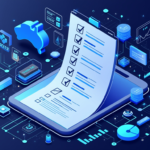In today’s fast-paced business environment, organisations are increasingly turning to advanced technologies like Artificial Intelligence (AI) to address workplace challenges and ensure compliance with complex legal regulations. AI-driven data analytics has emerged as a field-changing tool, providing employers with innovative approaches to tackle a variety of issues, from HR bottlenecks to managing compliance risks. In this blog post, I delve into how AI data analytics solutions are revolutionising workplace management while aiding legal compliance, particularly in areas such as labour laws, workplace safety, and employee relations.
Understanding AI in the Workplace
AI in the workplace goes beyond automating mundane tasks—it offers predictive insights, enhances decision-making, and ensures that businesses remain agile amidst expanding compliance obligations. By leveraging data-driven insights, organisations can uncover patterns and trends that would have otherwise been difficult to identify with traditional methods.
Employers can harness AI solutions to address specific pain points:
- Streamlining HR functions: From talent acquisition to performance reviews, AI simplifies complex processes.
- Promoting workplace safety: Predictive analytics can identify potential hazards before they escalate into major risks.
- Maintaining legal compliance: Automated systems ensure adherence to standards, minimising the risk of non-compliance penalties.
Key Workplace Challenges Solved by AI Data Analytics
Let’s explore some of the major workplace challenges that AI-driven data analytics addresses, providing both tangible and intangible benefits for employers and employees alike.
1. Wage and Hour Compliance
Managing wage and hour compliance is a daunting task for many employers. With federal, state, and sometimes local regulations often varying, the risk of errors can be high. AI analytics tools can assist in streamlining payroll management by tracking hours worked, predicting overtime needs, and ensuring compliance with wage laws. Employers can also use these solutions to detect anomalies, such as time theft or inaccuracies in reporting, promoting fairness and transparency.
2. Combatting Workplace Discrimination and Harassment
AI solutions play a vital role in fostering safer and more inclusive workplace environments. By analysing communication patterns and employee feedback, organisations can identify potential risks of harassment or discrimination. This proactive approach enables employers to address issues before they escalate, thereby maintaining a respectful and equitable workplace culture.
3. Mitigating Litigation Risks
Litigation is a costly and time-consuming challenge faced by many organisations. AI-powered analytics helps businesses reduce the likelihood of legal disputes by ensuring policy compliance and identifying breaches early on. Regular audits facilitated by AI tools can also enhance transparency and accountability across the organisation.
4. Enhancing Workplace Safety
Keeping the workplace safe is a top priority for employers. AI can analyse data from sensors, cameras, and employee reports to identify hazards and recommend corrective actions. For example, in industries like construction and manufacturing, predictive analytics can flag unsafe equipment or high-risk areas, safeguarding employees and reducing the likelihood of accidents.
5. Managing Trade Secrets and Non-Compete Agreements
AI data analytics can help organisations protect sensitive information and ensure compliance with non-compete agreements. Advanced algorithms monitor data usage patterns, access logs, and communication channels to detect potential breaches of confidentiality. This not only secures proprietary information but also strengthens trust between employers and employees.
The Role of AI in Legal Compliance
Legal compliance is one of the cornerstones of efficient workplace management. With constantly evolving regulations, staying up-to-date can be complex for employers. AI technology simplifies this process through real-time insights and automated tracking of compliance measures. Here are some of the ways AI supports legal compliance:
- Monitoring regulatory changes: AI tools continuously track updates to labour laws and safety regulations, ensuring organisations adapt promptly.
- Conducting compliance audits: Automated systems can identify gaps and recommend corrective actions to stay compliant.
- Reducing human error: By automating repetitive and error-prone tasks, AI minimises mistakes that could lead to costly penalties.
Final Thoughts: Embracing AI for a Better Workplace
The integration of AI data analytics into workplace management is no longer a luxury—it’s a necessity. From streamlining HR processes to fortifying legal compliance, AI offers myriad benefits for businesses looking to remain competitive in today’s ever-evolving landscape. By investing in these innovative solutions, organisations can not only reduce risks but also foster a supportive and productive working environment.
Ready to embrace automation? Check out our Step-by-Step Guide to Implementing A.I. in Small Law Firms to start transforming your firm today.
Need help choosing the right AI tools? Also checkout my 2024-25 AI Legal Tools Evaluation Checklist
To access a detailed timeline for rolling out AI tools and a easy-to-use comprehensive checklist, click here for the full guide.
Need guidance on choosing the right legal AI tools for your firm? Book a consultation with Andrew Easterbrook, a lawyer with 20 years of experience helping Australian law firms streamline their operations through AI and automation. With expertise in both legal practice and AI technology, I can help you make informed decisions about the tools that will work best for your practice.
Contact us for more information about our consulting service here








